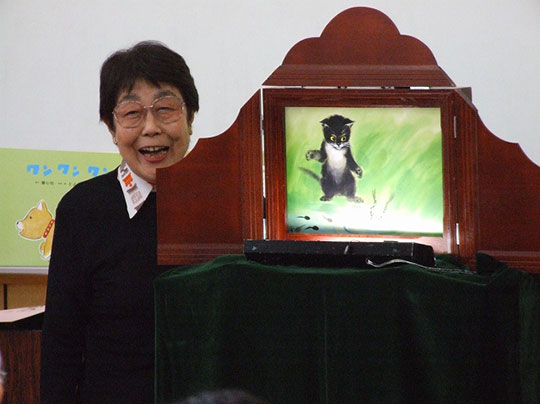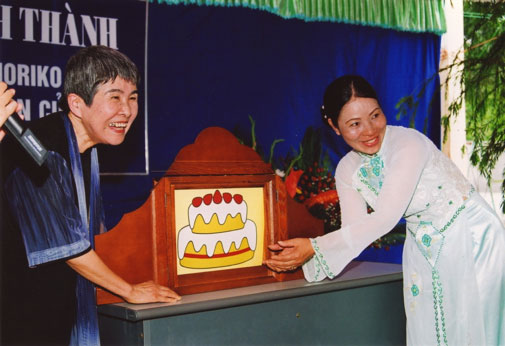
 |
 |
 |
 |
 |
|||||||
|
|---|
|
|
Honoring Two Giants of Post-War Kamishibai:Ute Kazuko (1927-2011) & Matsui Noriko (1934-2017)By Dr. Tara M. McGowanThe International Kamishibai Association of Japan (IKAJA) has designated December 7th as World Kamishibai Day because their organization was founded on that day in the year 2001. In the US, it also coincides with Pearl Harbor Day, and IKAJA welcomes this association because their mission is to spread world peace through the activation of kyōkan, or "shared feeling" in kamishibai performance. Thanks to IKAJA's activities, the Japanese word kyōkan is now recognized in many countries throughout the world. It is important to remember, however, that kyōkan has also been used for negative purposes, notably for propaganda during World War II. War-propaganda kamishibai effectively channeled the emotions of the Japanese people with such slogans as: "Ichioku, Isshin" 100 million united as one! Kyōkan is sometimes translated as "empathy," but not so much in the sense of compassion (dōjō in Japanese) as in experiencing matching emotions. At its best, kyōkan builds a sense of community by bringing people of different backgrounds together for a shared emotional experience. In this age of social media, where everyone can stay in their own individualized bubbles, such shared emotional experiences have become increasingly rare. This may well explain the popularity of kamishibai around the world today! If we can channel kyōkan to bring communities together, while also embracing and even celebrating our differences, then it might be possible to achieve peace, at least at the local level. For World Kamishibai Day, it seems particularly fitting to celebrate the differences between two giants of post-war kamishibai, who brought unique talents to the artform and thereby developed distinctive but equally valid approaches—Ute Kazuko and Matsui Noriko.1 Ute Kazuko (1927-2011) Ute Kazuko's roots in kamishibai go back to her father, Ute Gojō, a street-performance artist during the heyday of gaitō kamishibai. He was also active during World War II, as a member of the Japanese Educational Kamishibai Association. After the war, he continued his kamishibai work at the publishing company Tokyo Gageki. One of his innovations was to create a light source, which could be placed at the bottom of the stage to illuminate the cards so they could be performed in bomb shelters or other darkened venues. Gojō's eldest daughter Kazuko was born in Tokyo and grew up surrounded by kamishibai performers. She attended drama school and became a well-known voice-over artist for animé, both in television and film. Later, she returned to the world of kamishibai and became leader of the Hyōshigi group in Tokyo, giving frequent seminars and workshops. She published several books and book chapters on kamishibai and received the Special Takahashi Gozan Prize in 1985 for her contributions to the field.2 By the end of her career, she was recognized as the leading performer of kamishibai in Japan, and in 2016, the Children's Cultural Research Center in Tokyo created a prize in both her and her father's names to honor those, who, like Ute Kazuko and Ute Gojō, have had a significant impact on the world of kamishibai in Japan. 
Ute Kazuko (http://blog.livedoor.jp/ofuroudo/archives/51529821.html) Ute Kazuko was a proponent of using a paper curtain at the beginning of a story and opening it to the rhythm of the hyōshigi clappers. The color and pattern of the curtain could be adapted to set the mood for the story and was a common feature of street performance and early published kamishibai. At the end, she would reinsert the curtain into the stage, as she brought the story to a close. The use of a curtain card, instead of opening and closing the stage doors, made it possible to use her father's invention of a light source at the bottom of the stage. As a renowned voice-over artist, Ute read with great expression, changing her voice to match the emotions of each of the characters. The extraordinary range of her voice made her performances of narrative kamishibai particularly admired.3 Buddhist priest and kamishibai artist, Morohashi Seikō, who creates giant tatami-sized kamishibai stories that are often vehicles for Buddhist teachings, recently said of her: "It was through meeting Ute Kazuko-sensei and being exposed to the profundity of her storytelling, that I was able to see how kamishibai could be a powerful tool to help people deeply grasp the meaning of Buddhist parables and the difficult and nuanced literary tales of classical children's literature." Ute Kazuko was also a supporter of the tezukuri(hand-made) kamishibai movement. I remember attending a gathering with her during the Minoh tezukuri kamishibai festival in Osaka prefecture, where we discussed the need to bridge the differences between performers in Tokyo, where the three-doored stage is commonly used, and those in the kansai region (western part of Japan), who favor stages with no doors. Having no doors makes sense in Osaka, where kamishibai is more dramatic, interactive, and improvisational. Like the street performers of the past, storytellers in Osaka do not read their stories, and they often draw attention to themselves by interacting with the audience during the performance. Although there were and still are tensions over these differences, Ute Kazuko recognized the need to work together and allow for a spectrum of approaches, whether they came out of street-performance, educational, or tezukuri kamishibai. Her many followers in Japan continue to carry on her method of performing kamishibai today. Matsui Noriko (1934-2017) Many kamishibai performers outside Japan are already familiar with the theories of Matsui Noriko because she is the one who developed the methods promoted by IKAJA in How to Perform Kamishibai Q & A (hereafter, Q & A). Readers familiar with the IKAJA method will immediately notice that there are significant differences between Ute Kazuko's approach and IKAJA's. For example, IKAJA promotes opening the doors of the 3-door stage in a very specific way to start the story and to close it again at the end. They discourage the use of curtains and the use of lights inside the stage, as well as changes of voice for the characters. In fact, they claim that making kamishibai into too much of a dramatic performance detracts from the effective channeling of kyōkan. To understand the source of these differences, it is important to realize that Matsui Noriko did not come to kamishibai with a background in the performing arts but rather as a successful picture-book illustrator. After graduating from Musashino Art University, she illustrated picture books for at least a decade before setting her hand to creating kamishibai. She describes her process of discovery in her book Kyōkan no yorokobi (The joys of shared feeling), which became the basis of Q & A. 
Matsui Noriko (Photo courtesy of Matsui Eiko) The most important aspect of kamishibai for Matsui, as an illustrator, was to create or select high quality, published kamishibai stories that "convey a message from the Truth of Life" (Q&A, p.13). As an artist, she particularly excelled at participatory stories with clever visual effects. Her "Grow, Grow, Grow Bigger" and "Le chef cuisinier est de mauvais poil" (The chef in a bad humor) are now beloved and performed worldwide, and her stories, as well as her kamishibai methods and theories, are available in at least six languages. Although Matsui passed away in 2017, her work lives on through the ongoing publication and dissemination of her stories by the publisher Dōshinsha and the activities of IKAJA around the globe. When I speak with Japanese representatives of IKAJA and with non-Japanese kamishibai performers from the different countries where they are active, I cannot help noticing a conflict of expectations on both sides. For one thing, non-Japanese kamishibai enthusiasts are often attracted to the format precisely because of its roots as a street-performance art, especially when they learn of its historical connection to manga and animé. They buy bicycles and make stages to fit on the back, and they go out into the parks and streets in their neighborhoods. When I spoke with IKAJA representatives in Japan recently, they said they found this attraction to street performance difficult to understand. After all, their work is devoted to elevating kamishibai and actively disassociating it from its past as a street-performance art and vehicle for war propaganda. Conversely, many non-Japanese performers I encounter express concern over performing kamishibai in a "traditional" Japanese way, but tradition is not IKAJA's focus. In fact, IKAJA describes itself as launching "A New Kamishibai Movement" (Newsletter, vol.10) and spreading it to the world. Their methods are based on Matsui Noriko's theory of how best to channel kyōkan and Doshinsha's careful selection of what it considers to be superior published works, not any specific tradition. IKAJA fervently believes that they are elevating kamishibai to its pure essence and that spreading this essence to the world will lead to greater peace and harmony. From this point of view, bicycles, curtains, and outdoor settings distract from this pure form. Toward a truly World Kamishibai Day For those attracted to IKAJA's methods, there is much to be said for the purity of their mission and ideals, but, for those drawn to the more popular and performative aspects of kamishibai, IKAJA's methods may seem unnecessarily restrictive. As I have traveled around the world, meeting kamishibai performers, artists, and enthusiasts, I am struck by how—just as in the cases of Ute Kazuko and Matsui Noriko—every individual brings to this format his or her own unique background and set of talents. In Central America, performances involve colorfully decorated stages and elaborate rituals for opening them. In Slovenia, music and poetry are taking the format in new directions.4 It is entirely possible that the best way of channeling kyōkan may be different, depending on cultural context. World Kamishibai Day provides us with an opportunity to celebrate, not only the formation of IKAJA and their New Kamishibai Movement, but also all the other kamishibai movements and methods, both new and old, within Japan and around the world, as we revel in the full spectrum of kamishibai's creative possibilities.
1 In this article, I will follow the Japanese name order, which has the last name first.
2 One of her best know books is titled Kamishibai no hajimari hajimari: Kamishibai no jōzuna enjikata (Kamishibai is about to begin: How to perform kamishibai), published in 1986 by Dōshinsha. 3 For an example of Ute Kazuko performing the narrative kamishibai "The Oni Who Sank to the Bottom of the Sea," see http://kamishibai.com/spotlight/oniwhosank.html 4 For my interviews from Mexico, see http://kamishibai.com/spotlight/tara-intro.html and from Slovenia, see http://kamishibai.com/spotlight/slovenia.html |
|---|
 |
|---|
|
Kamishibai for Kids ~ 2358 University Avenue #179, San Diego, CA 92104 |